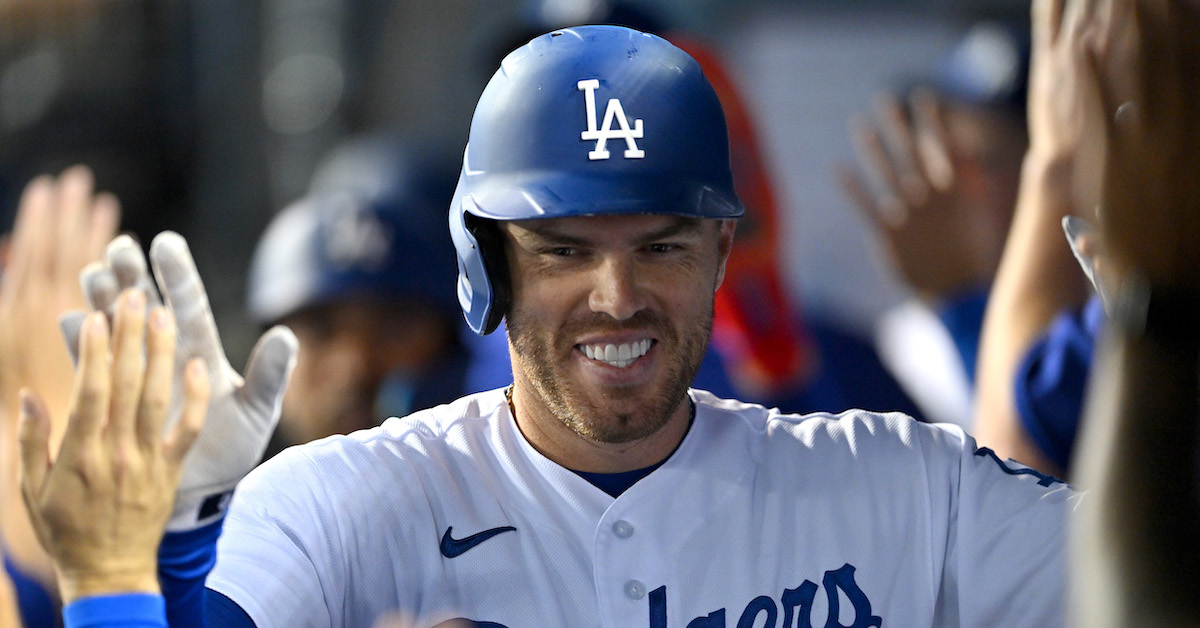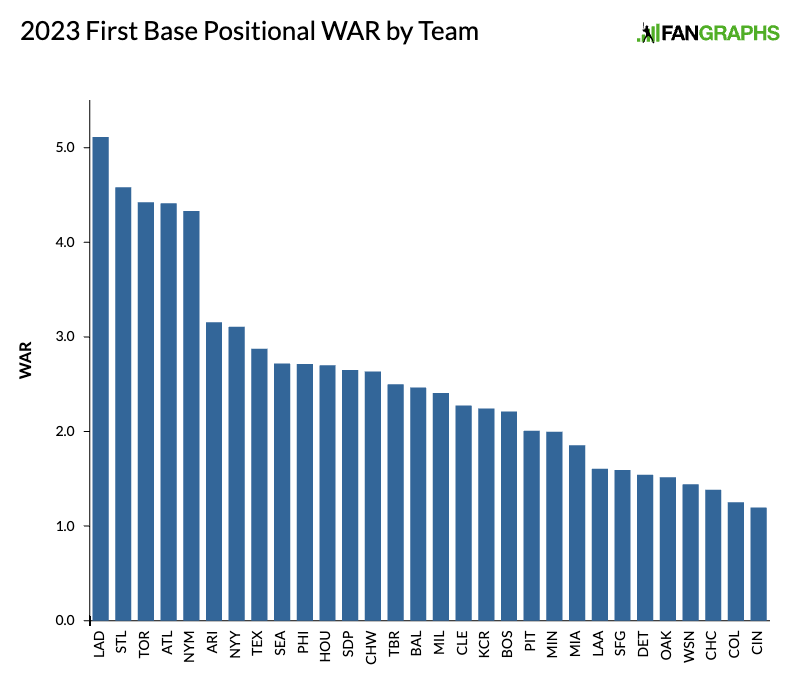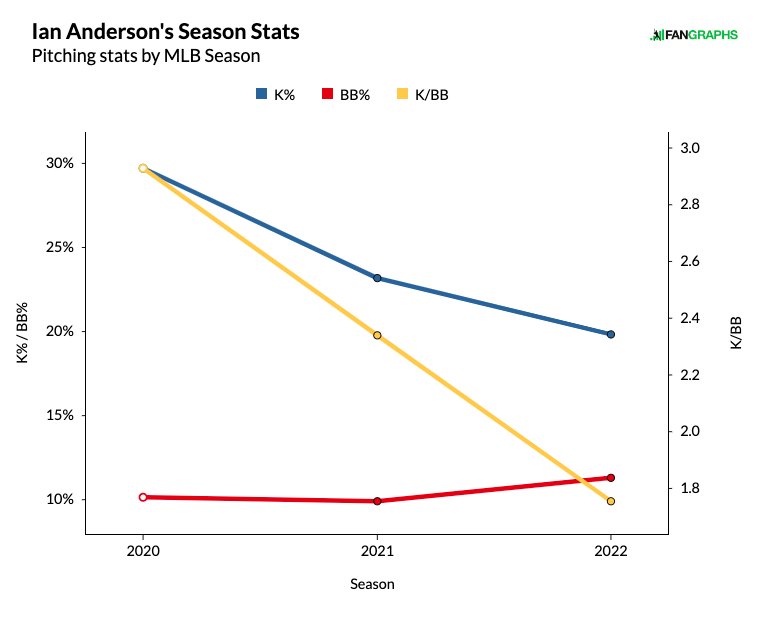Andrés Giménez Is the Latest Guardian to Sign a Long-Term Extension

Last year, Andrés Giménez enjoyed quite a breakout season, helping to lessen the sting of the Francisco Lindor trade by emerging as one of the top second basemen in the game. He made his first All-Star team, won his first Gold Glove, and helped the Guardians win the AL Central for the first time since 2018. Now, the team has guaranteed that he’ll stick around for a good long while. On Tuesday, ESPN’s Jeff Passan reported that Giménez has agreed to terms on a seven-year, $106.5 million extension that also includes an option for an eighth season.
The full details of the contract have not yet been reported, but the deal appears to cover the 2023-29 seasons, with a $4 million signing bonus and a $23 million club option for 2030 that comes with a $2.5 million buyout. Via as-yet-unspecified escalators, that option can increase to $24 million (note that Passan has reported the option year as 2031, meaning that the guaranteed portion of the deal wouldn’t begin until next season). At its maximum, the extension could pay Giménez $128 million over eight years, his ages 24-31 seasons.
The guaranteed portion of the contract is the second-largest in team history after José Ramírez’s five-year, $124 million extension signed last year. The extension is the latest manifestation of what has practically become a Cleveland tradition, one that traces back to the rebirth of the franchise. In the mid-1990s, general manager John Hart pioneered the practice of signing young stars such as Sandy Alomar Jr., Carlos Baerga, Manny Ramirez, Jim Thome, and Omar Vizquel to extensions that ran through at least some of their arbitration years and kept them in the fold when they would have hit free agency. It’s a strategy that enabled the team to save millions of dollars while maintaining a competitive nucleus, and one that has become popular with several other teams, most notably the Braves (for whom Hart served as president of baseball operations from late 2014 to late ’17). Long after Hart left Cleveland, successors Mark Shapiro and Chris Antonetti continued to sign players such as Ramírez, Michael Brantley, Travis Hafner, Jason Kipnis, Corey Kluber, Carlos Santana, and Grady Sizemore to deals along those lines.
That’s an incomplete list of players who went this route, but it never included Lindor, who went year-to-year during his arbitration years until the team decided it couldn’t afford him at a full market price. On January 7, 2021, Lindor and Carlos Carrasco were traded to the Mets in exchange for the then-22-year-old Giménez, shortstop Amed Rosario, outfielder Isaiah Greene and righty Josh Wolf.
Giménez had hit an impressive .263/.333/.398 (105 wRC+) in 49 games with the Mets during the pandemic-shortened 2020 season, but he struggled in his first year with Cleveland, batting .218/.282/.351 (74 RC+) in 68 games sandwiched around a detour to Triple-A Columbus that lasted nearly three months. He did hit much better after returning (.245/.320/.382, 94 wRC+) than before (.179/.226/.308, 43 wRC+) even if he didn’t actually make better contact. As I noted last fall, he held his own after returning despite lacking a consistent approach at the plate. “Last year [2021] he’d deviate after like a bad game,” manager Terry Francona told the Akron Beakon Journal’s Ryan Lewis in May. “You’d have different stance, you have a leg kick you didn’t have, you get a toe-tap.”
Guardians hitting coaches Chris Valaika and Victor Rodriguez helped Giménez ditch the leg kick, which they felt was hindering his pitch recognition and his timing. He fared better against every major pitch type in 2022 than ’21, and overall batted .297/.371/.466 with 17 homers and 20 steals. His 140 wRC+ finished in a virtual tie with Rafael Devers and Carlos Correa for eighth in the AL (one point ahead of Ramírez) and among second basemen of either league trailed only Jose Altuve and Jeff McNeil. On the other side of the ball, Giménez’s 16 DRS, 9 OAA and 6.5 UZR each ranked second among all second basemen, and overall, his 6.1 WAR tied Xander Bogaerts for fifth in the AL, and among second basemen trailed only Altuve. That’s some fine company.
Giménez’s performance included a few areas of concern, notably a 40.8% chase rate, 6.1% walk rate, and Statcast contact numbers (87.8 mph average exit velocity, 6.2% barrel rate, 37.6% hard-hit rate) that placed only in the 29th–36th percentiles. Thanks in part to his 94th-percentile speed, he was nonetheless one of the majors’ most productive hitters on groundballs, ranking among the top half-dozen in both batting average and wRC+:
| Player | Tm | PA | AVG | SLG | wRC+ |
|---|---|---|---|---|---|
| Harold Ramírez | TBR | 176 | .347 | .392 | 116 |
| Jeff McNeil | NYM | 195 | .338 | .400 | 114 |
| Julio Rodríguez | SEA | 169 | .343 | .367 | 108 |
| Xander Bogaerts | BOS | 207 | .343 | .386 | 103 |
| Andrew Benintendi | KCR/NYY | 167 | .335 | .353 | 94 |
| Andrés Giménez | CLE | 171 | .333 | .345 | 94 |
| Yandy Díaz | TBR | 206 | .306 | .350 | 90 |
| José Ramírez | CLE | 171 | .310 | .363 | 90 |
| Adolis García | TEX | 174 | .316 | .351 | 89 |
| Trea Turner | LAD | 226 | .319 | .350 | 89 |
As noted last fall, hitters combined for a .235 AVG and 35 wRC+ on grounders; based on that, Giménez netted an extra 17 hits, without which he’d have finished with a .263 AVG and .433 SLG, much closer to his expected numbers.
While I do wonder about the sustainability of that aspect of his game, in all, that’s a pretty impressive showing for a 23-year-old. In fact, it’s one of the best age-23 seasons of the past decade:
| Player | Team | Season | PA | HR | SB | AVG | OBP | SLG | wRC+ | BsR | Off | Def | WAR |
|---|---|---|---|---|---|---|---|---|---|---|---|---|---|
| Mike Trout | LAA | 2015 | 682 | 41 | 11 | .299 | .402 | .590 | 171 | 3.0 | 58.7 | 6.6 | 9.3 |
| Mookie Betts | BOS | 2016 | 730 | 31 | 26 | .318 | .363 | .534 | 136 | 10.6 | 41.8 | 13.0 | 8.2 |
| Cody Bellinger | LAD | 2019 | 660 | 47 | 15 | .305 | .406 | .629 | 161 | 1.4 | 54.2 | 4.5 | 7.7 |
| Manny Machado | BAL | 2016 | 696 | 37 | 0 | .294 | .343 | .533 | 131 | 0.1 | 25.7 | 11.4 | 6.2 |
| Kris Bryant | CHC | 2015 | 650 | 26 | 13 | .275 | .369 | .488 | 136 | 6.9 | 33.8 | 3.6 | 6.1 |
| Francisco Lindor | CLE | 2017 | 723 | 33 | 15 | .273 | .337 | .505 | 116 | 4.7 | 19.4 | 17.7 | 6.1 |
| Andres Giménez | CLE | 2022 | 557 | 17 | 20 | .297 | .371 | .466 | 140 | 3.4 | 28.3 | 12.0 | 6.1 |
| Yasiel Puig | LAD | 2014 | 640 | 16 | 11 | .296 | .382 | .480 | 148 | 1.6 | 36.3 | -5.5 | 5.5 |
| Corey Seager | LAD | 2017 | 613 | 22 | 4 | .295 | .375 | .479 | 127 | 3.4 | 24.9 | 8.7 | 5.4 |
| José Ramírez | CLE | 2016 | 618 | 11 | 22 | .312 | .363 | .462 | 119 | 8.6 | 22.9 | 7.4 | 5.3 |
| Bo Bichette | TOR | 2021 | 690 | 29 | 25 | .298 | .343 | .484 | 122 | 6.9 | 25.2 | 2.4 | 5.1 |
| Freddie Freeman | ATL | 2013 | 629 | 23 | 1 | .319 | .396 | .501 | 150 | 1.5 | 36.9 | -9.5 | 5.0 |
Again, fine company even given the presence of a few players who have flamed out; Bellinger and Bryant have both dealt with a series of injuries, while Puig’s decline has been an ugly mixture of on- and off-field issues. The book isn’t closed on any of the above players, but several are Cooperstown bound. It’s worth noting that the two other Cleveland players on the list have turned out quite well, and that Giménez’s 140 wRC+ is actually higher than all of the other non-first base infielders — even those who out-homered him by a significant margin.
Because Giménez spent so long in the minors in 2021, he’s accrued only two years and 106 days of major league service time, 66 short of reaching three full seasons (which would have made him eligible for free agency after the 2025 season) and 22 short of becoming an arbitration-eligible Super Two. Thus, his contract for 2023 was among the 28 the team recently renewed; most of those salaries haven’t even been published yet, but Giménez was only set to make $739,400. The $4 million signing bonus bumps him up to something closer to what a star-caliber player in his first year of arbitration eligibility might make. For example, Bichette, who’s heading into his age-25 season with 3.063 years of service time, is making $2.85 million in salary plus a $3.25 million signing bonus as part of his three-year, $33.6 million extension, while the Padres’ Jake Cronenworth, who has exactly three years of service time, is making $4.225 million coming off back-to-back 4.1-WAR seasons. Had he reached three years, Giménez might be somewhere in that ballpark.
Via Dan Szymborski, here’s Giménez’s projection through 2030, the year with the club option:
| Year | Age | BA | OBP | SLG | AB | H | HR | SO | SB | OPS+ | WAR | $ | $Arb |
|---|---|---|---|---|---|---|---|---|---|---|---|---|---|
| 2023 | 24 | .266 | .336 | .416 | 515 | 137 | 15 | 119 | 20 | 108 | 4.4 | $36.9 | $0.7 |
| 2024 | 25 | .265 | .336 | .420 | 517 | 137 | 16 | 115 | 19 | 109 | 4.5 | $39.6 | $7.9 |
| 2025 | 26 | .264 | .338 | .419 | 515 | 136 | 16 | 112 | 18 | 110 | 4.5 | $42.1 | $14.7 |
| 2026 | 27 | .260 | .334 | .416 | 515 | 134 | 16 | 109 | 16 | 108 | 4.0 | $38.5 | $17.4 |
| 2027 | 28 | .257 | .333 | .409 | 514 | 132 | 16 | 106 | 15 | 105 | 3.6 | $35.5 | — |
| 2028 | 29 | .255 | .333 | .407 | 513 | 131 | 16 | 105 | 13 | 105 | 3.2 | $32.9 | — |
| 2029 | 30 | .255 | .333 | .407 | 513 | 131 | 16 | 106 | 12 | 105 | 2.9 | $30.4 | — |
| 2030 | 31 | .257 | .334 | .409 | 513 | 132 | 16 | 106 | 11 | 106 | 2.8 | $31.3 | — |
Even with some regression to 4.5 WAR per year at his peak, the ZiPS contract projection for Giménez if he were a free agent comes to a whopping $287.2 million, which is more than Bogaerts received from the Padres as a 30-year-old free agent (and spread out over 11 years, at that). Even with the expected discounts for his arbitration years, Giménez projects to be worth $139.5 million through 2029, and $170.8 million through ’30; through that lens, this looks like a rather club-friendly deal. It’s not an out-and-out steal the way Ramírez’s five-year, $26 million deal for 2017-21 — over which the third baseman produced 28 WAR, made three All-Star teams and finished in the top three in AL MVP voting three times — turned out to be, but it’s clear that Giménez traded some risk for financial security. If he’s still even close to being a three-win player in 2030, he’ll stand to make tens of millions more, though he’s unlikely to approach the windfall he might have reaped if he’d spent all of 2021 in the majors and hit free agency after 2025, his age-26 season.
All of which is to say that this is A Very Guardians Deal, and while we can again bemoan the salary structure that prevents players short of six years of service time from getting anything approaching their full market value, it takes two sides to tango. And we shouldn’t be surprised if at least a couple more extensions follow in short order. Via The Athletic’s Zack Meisel, the team is in “advanced negotiations” with multiple players including Rosario, Triston McKenzie, Steven Kwan, and Trevor Stephan, hoping to complete extensions by Opening Day (Stephan’s is reportedly nearing completion). Meanwhile, Emmanuel Clase (five years, $20 million) and Myles Straw (five years, $25 million) signed such deals last spring, albeit at a scale much smaller than that of Giménez. If some of those extensions come though, they’ll probably increase the team’s payroll — estimated at around $90.7 million even with several of those aforementioned extension candidates’ salaries unknown — by a few million dollars. They’re still likely to rank among the bottom third of the 30 teams, even while contending for another AL Central title or at least a playoff spot. This approach has worked for the Guardians before, and at least in terms of establishing generational wealth for Giménez, it will work for him as well.









